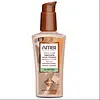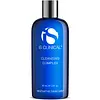What's inside
What's inside
 Key Ingredients
Key Ingredients

 Benefits
Benefits

 Concerns
Concerns

 Ingredients Side-by-side
Ingredients Side-by-side

Water
Skin ConditioningAloe Barbadensis Leaf Juice
Skin ConditioningCocamidopropyl Betaine
CleansingSodium Lauroyl Methyl Isethionate
CleansingGlycerin
HumectantIpomoea Batatas Extract
Skin ConditioningChamomilla Recutita Extract
Skin ConditioningCamellia Sinensis Extract
AntioxidantPropanediol
SolventRetinyl Palmitate
Skin ConditioningCopper Sulfate
Skin ConditioningTocopheryl Acetate
AntioxidantCalendula Officinalis Extract
Skin ConditioningPEG-12 Dimethicone
Skin ConditioningBixa Orellana Pulp Extract
MaskingCitric Acid
BufferingPhenoxyethanol
PreservativeEthylhexylglycerin
Skin ConditioningWater, Aloe Barbadensis Leaf Juice, Cocamidopropyl Betaine, Sodium Lauroyl Methyl Isethionate, Glycerin, Ipomoea Batatas Extract, Chamomilla Recutita Extract, Camellia Sinensis Extract, Propanediol, Retinyl Palmitate, Copper Sulfate, Tocopheryl Acetate, Calendula Officinalis Extract, PEG-12 Dimethicone, Bixa Orellana Pulp Extract, Citric Acid, Phenoxyethanol, Ethylhexylglycerin
Water
Skin ConditioningDisodium Laureth Sulfosuccinate
CleansingCocamidopropyl Betaine
CleansingPEG-30 Glyceryl Cocoate
EmulsifyingGlycerin
HumectantPropylene Glycol
HumectantHydroxyethylcellulose
Emulsion StabilisingSalix Alba Bark Extract
AstringentSaccharum Officinarum Extract
MoisturisingCamellia Sinensis Leaf Extract
AntimicrobialChamomilla Recutita Flower Extract
MaskingAsiaticoside
AntioxidantAsiatic Acid
Skin ConditioningMadecassic Acid
Skin ConditioningAscorbyl Palmitate
AntioxidantPhospholipids
Skin ConditioningTocopheryl Acetate
AntioxidantRetinyl Palmitate
Skin ConditioningIodopropynyl Butylcarbamate
PreservativePhenoxyethanol
PreservativeWater, Disodium Laureth Sulfosuccinate, Cocamidopropyl Betaine, PEG-30 Glyceryl Cocoate, Glycerin, Propylene Glycol, Hydroxyethylcellulose, Salix Alba Bark Extract, Saccharum Officinarum Extract, Camellia Sinensis Leaf Extract, Chamomilla Recutita Flower Extract, Asiaticoside, Asiatic Acid, Madecassic Acid, Ascorbyl Palmitate, Phospholipids, Tocopheryl Acetate, Retinyl Palmitate, Iodopropynyl Butylcarbamate, Phenoxyethanol
 Reviews
Reviews

Ingredients Explained
These ingredients are found in both products.
Ingredients higher up in an ingredient list are typically present in a larger amount.
Cocamidopropyl Betaine is a fatty acid created by mixing similar compounds in coconut oil and dimethylaminopropylamine, a compound with two amino groups.
This ingredient is a surfactant and cleanser. It helps gather the dirt, pollutants, and other impurities in your skin to be washed away. It also helps thicken a product and make the texture more creamy.
Being created from coconut oil means Cocamidopropyl Betaine is hydrating for the skin.
While Cocamidopropyl Betaine was believed to be an allergen, a study from 2012 disproved this. It found two compounds in unpure Cocamidopropyl Betaine to be the irritants: aminoamide and 3-dimethylaminopropylamine. High-grade and pure Cocamidopropyl Betaine did not induce allergic reactions during this study.
Learn more about Cocamidopropyl BetaineGlycerin is already naturally found in your skin. It helps moisturize and protect your skin.
A study from 2016 found glycerin to be more effective as a humectant than AHAs and hyaluronic acid.
As a humectant, it helps the skin stay hydrated by pulling moisture to your skin. The low molecular weight of glycerin allows it to pull moisture into the deeper layers of your skin.
Hydrated skin improves your skin barrier; Your skin barrier helps protect against irritants and bacteria.
Glycerin has also been found to have antimicrobial and antiviral properties. Due to these properties, glycerin is often used in wound and burn treatments.
In cosmetics, glycerin is usually derived from plants such as soybean or palm. However, it can also be sourced from animals, such as tallow or animal fat.
This ingredient is organic, colorless, odorless, and non-toxic.
Glycerin is the name for this ingredient in American English. British English uses Glycerol/Glycerine.
Learn more about GlycerinPhenoxyethanol is a preservative that has germicide, antimicrobial, and aromatic properties. Studies show that phenoxyethanol can prevent microbial growth. By itself, it has a scent that is similar to that of a rose.
It's often used in formulations along with Caprylyl Glycol to preserve the shelf life of products.
Retinyl palmitate is a form of retinoid. Retinoids are the superstar class of anti-aging ingredients that include tretinoin and retinol.
This particular ingredient has had a bumpy year with its rise and fall in popularity.
First, Retinyl palmitate is created from palmitic acid and retinol. It is a retinol ester and considered one of the weaker forms of retinoid.
This is because all retinoids have to be converted to Tretinoin, AKA retinoic acid. Retinyl Palmitate is pretty far down the line and has to go through multiple conversions before its effects are seen.
Due to this long and ineffective conversion line, the benefits of Retinyl Palmitate are debated.
Studies show Retinyl Palmitate to help:
Dermatologists say this ingredient is ineffective because it isn't used in high enough concentrations in cosmetics.
This ingredient used to be found in sunscreens to boost the efficacy of sunscreen filters.
The downfall of Retinyl Palmitate was due to released reports about the ingredient being correlated to sun damage and skin tumors.
While there is a study showing this ingredient to cause DNA damage when exposed to UV-A, there is no concrete proof of it being linked to skin cancer. It is safe to use when used correctly.
All retinoids increase your skin's sensitivity to the sun in the first few months of usage. Be especially careful with reapplying sunscreen when using any form of retinoid.
Currently, this ingredient is still allowed in cosmetics all over the world. In Canada, cosmetics must have a warning label stating the product to contain Retinyl Palmitate
Fun fact: This ingredient is often added to low-fat milk to increase the levels of Vitamin A.
Learn more about Retinyl PalmitateTocopheryl Acetate is AKA Vitamin E. It is an antioxidant and protects your skin from free radicals. Free radicals damage the skin by breaking down collagen.
One study found using Tocopheryl Acetate with Vitamin C decreased the number of sunburned cells.
Tocopheryl Acetate is commonly found in both skincare and dietary supplements.
Learn more about Tocopheryl AcetateWater. It's the most common cosmetic ingredient of all. You'll usually see it at the top of ingredient lists, meaning that it makes up the largest part of the product.
So why is it so popular? Water most often acts as a solvent - this means that it helps dissolve other ingredients into the formulation.
You'll also recognize water as that liquid we all need to stay alive. If you see this, drink a glass of water. Stay hydrated!
Learn more about Water